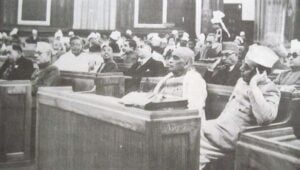The Drafting Committee worked for 141 days, spread over a period of two years and 11 months. It prepared five drafts of the constitution: the first draft in February 1948, the second draft in October 1948, the third draft in November 1948, the fourth draft in January 1949 and the final draft in November 1949.
The Constituent Assembly of India had a set procedure for discussing and deciding each article and clause of the Draft Constitution. The amendments were submitted to the President in advance on each day of the session. The President of the Assembly, Dr. Rajendra Prasad would announce the article or clause and invite members to move and explain their amendments. The members would also speak on the original article or clause and express their views. The member in charge of the article or clause would reply to the debate and accept or reject the amendments. The President would then put each amendment and the article or clause to vote by the members. The voting was done by the method of a single transferable vote of proportional representation. This means that each member had one vote but could rank the amendments in order of preference. If an amendment did not get a majority of votes, the votes of the lowest-ranked amendment were transferred to the next preference until a majority was achieved. The Constituent Assembly adopted 2473 amendments out of 7635 (32.4%) proposed amendments.

Constitutional Assembly Debates | Credit: Wikimedia Commons
The consideration and debate on each article and clause of the draft constitution was a rigorous and detailed exercise. It also involved a lot of compromise and accommodation among different groups and interests in the assembly. Some of the major issues and controversies that were debated during this process were:
- Fundamental Rights: The scope, content and limitations of Fundamental Rights were extensively debated in the Assembly. Some members wanted more rights to be included, such as right to work, right to social security, right to privacy, etc. Others wanted more restrictions to be imposed on rights, such as public order, morality, security, etc. And some wanted special rights for minorities, women, backward classes, etc. There were members who wanted no rights for aliens, enemies, etc.
- Directive Principles: The nature, significance and enforceability of directive principles were also debated in the assembly. While some advocated making directive principles justiciable and binding on the government, others proposed granting them higher priority than fundamental rights. There were contrasting views on whether directive principles should be more specific and concrete or more flexible and dynamic.
- Citizenship: The criteria, conditions, and modes of acquiring and losing citizenship were subjects of intense debate. Suggestions ranged from basing citizenship solely on birth or domicile to combining both factors. The assembly members had differing opinions on whether citizenship should be primarily based on naturalisation.
- Federalism: The distribution of powers and functions between the centre and states were a major debate in the assembly. Some favoured granting more autonomy and authority to the states, while others supported increased central control and supervision. There were also calls for enhanced cooperation and coordination between the centre and states.
- Language: The choice and status of official language(s) for India were also debated in the assembly. Some advocated for Hindi as the sole official language, while others pressed for retaining English as an associate official language. There were proponents of granting equal status and recognition to regional languages as official languages for India.
This process was a remarkable demonstration of the democratic spirit and constitutional vision of the people of India. The Constituent Assembly adopted and enacted the constitution on 26 November 1949.
The Constituent Assembly took almost three years to complete its task. It studied various constitutions of other countries and incorporated their best features and consulted various experts and stakeholders from different fields and backgrounds. The Indian Constitution also incorporated features from other constitutions, such as the British, the American, the Irish, the Canadian and the Australian.
Continue to the next section: Borrowed from Around the World
